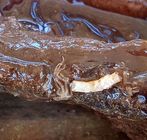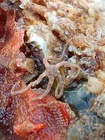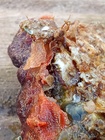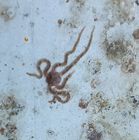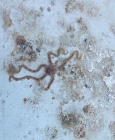
| Introduction | | Search taxa | | Taxon tree | | Taxon match | | Checklist | | Literature | | Stats | | Photogallery | | OBIS Vocab | | Log in |
CaRMS taxon detailsAmphipholis squamata (Delle Chiaje, 1828)
125064 (urn:lsid:marinespecies.org:taxname:125064)
accepted
Species
marine, brackish,
(of ) Delle Chiaje S. (1823-1831). Memorie sulla storia e notomia degli animali senza vertebre del regno di Napoli. <em>Napoli: Fratelli Fernandes (vol. 1), and Società Tipografica (vol. 2-4).</em> Vol. 1, pp. i-xii, 1-84 [1823], pp. 1-184 [1824]; vol. 2, pp. [1-4] + 185-224 [1825], pp. 225-444 [1826]; vol. 3, pp. i-xx, pp. 1-232 [1828]; vol. 4, pp. i-vii [1831], 1-116 [1830], pp. 117-214 [1831]; pl. 1-4; pl. 1-69 [date?], pl. 70-109 [1830][dates according to Sherborn, 1922]., available online at https://doi.org/10.5962/bhl.title.10021
page(s): In Volume III - Pag 74 [details]
Description Description: Arm length to 15 mm, disc diamter to 2.5 mm. Disc with obvious scales and with a pair of D-shaped radial...
Description Description: Arm length to 15 mm, disc diamter to 2.5 mm. Disc with obvious scales and with a pair of D-shaped radial shields, half the disc radius in length, twice as long as wide, contiguous. Three oral papillae on each side of the jaw. Aboral arm plates wider than long, distal margin convex. Three arm spines, as long as the segment. Two tentacle scales. Disc colour mottled bluish-grey and pink, the distal part of the radial shields standing out as a bright spot surrounded by darker colour. Arms marked with darker spots. Habitat: lower eulittoral on the underside of stones and among seaweed, and deeper on sand, mud and among seagrasses. Also recorded in SE Arabia, W India, Pakistan, East Indies, north Australia, Philippine, South Pacific Is. and Hawaiian Is. (Clark & Rowe, 1971); Australia (Kalk (1958) and Rowe & Gates (1995)); Lakshadeep (India) in Sastry (1991). General distribution: tropical Indo-Pacific in Kalk (1958); circumglobal (northeastern North America, northern Europe, South Africa, new Zealand, Indo-Pacific Ocean), depth range 0-500 m. (Rowe & Gates, 1995); temperate and tropical waters worldwide (Richmond, 1998). Ecology: benthic, inshore, continental shelf, continental slope (Rowe & Gates, 1995). [details] Distribution Intertidal to more than 200 m depth. Common along algae in tidepools and damp places , and under stones in gravel, from...
Distribution Intertidal to more than 200 m depth. Common along algae in tidepools and damp places , and under stones in gravel, from aboout mid-tide level down, all round the British Isles; occasional offshore among gravel and shells. Cosmopolitan in temperate and in warm seas, but A. squamata is probably a species complex, the individual species distinguishable by molecular methods only (Le Gac et al., 2004) [details] Distribution Cosmopolitan in temperate and warm temperate seas
Distribution Cosmopolitan in temperate and warm temperate seas [details] Distribution Arctic to Florida; Alaska to S. California
Distribution Arctic to Florida; Alaska to S. California [details]
Stöhr, S.; O’Hara, T.; Thuy, B. (Eds) (2024). World Ophiuroidea Database. Amphipholis squamata (Delle Chiaje, 1828). Accessed through: Nozères, C., Kennedy, M.K. (Eds.) (2024) Canadian Register of Marine Species at: https://www.marinespecies.org/carms/aphia.php?p=taxdetails&id=125064 on 2024-04-25
Nozères, C., Kennedy, M.K. (Eds.) (2024). Canadian Register of Marine Species. Amphipholis squamata (Delle Chiaje, 1828). Accessed at: https://marinespecies.org/carms/aphia.php?p=taxdetails&id=125064 on 2024-04-25
Date action by
original description
(of ) Delle Chiaje S. (1823-1831). Memorie sulla storia e notomia degli animali senza vertebre del regno di Napoli. <em>Napoli: Fratelli Fernandes (vol. 1), and Società Tipografica (vol. 2-4).</em> Vol. 1, pp. i-xii, 1-84 [1823], pp. 1-184 [1824]; vol. 2, pp. [1-4] + 185-224 [1825], pp. 225-444 [1826]; vol. 3, pp. i-xx, pp. 1-232 [1828]; vol. 4, pp. i-vii [1831], 1-116 [1830], pp. 117-214 [1831]; pl. 1-4; pl. 1-69 [date?], pl. 70-109 [1830][dates according to Sherborn, 1922]., available online at https://doi.org/10.5962/bhl.title.10021
page(s): In Volume III - Pag 74 [details] context source (Deepsea) Intergovernmental Oceanographic Commission (IOC) of UNESCO. The Ocean Biogeographic Information System (OBIS), available online at http://www.iobis.org/ [details] context source (HKRMS) Wai, H.Y. (2009) Effects of Deployment of Artificial Reefs on the Marine Benthic Environment, with Special Reference to Sediment Physico-Chemical Chanracteristics. MPhil thesis. City University of Hong Kong. [details] context source (BeRMS 2020) Aquatic environment and quality group; Flanders research institute for agriculture, fisheries and food (ILVO), Belgium; (2017): Subtidal macrobenthos monitoring in function of a foreshore suppletion at the Belgian coast, period 2013-2016. [details] context source (PeRMS) Solís-Marín, F. A.; Alvarado, J. J.; Abreu-Pérez, M.; Aguilera, O.; Alió, J.; Bacallado-Aránega, J. J.; Barraza, E.; Benavides-Serrato, M.; Benítez-Villalobos, F.; Betancourt-Fernández, L.; Borges, M.; Brandt, M.; Brogger, M. I.; Borrero-Pérez, G. H.; Buitrón-Sánchez, E.; Campos, L. S.; Cantera, J.; Clemente, S.; Cohen-Renjifo, M.; Coppard, S.; Costa-Lotufo, L. V.; del Valle-García, R.; Díaz, Y.; Díaz de Vivar, M. E.; Díaz-Martínez, J. P.; Durán-González, A.; Epherra, L.; Escolar, M.; Francisco, V.; Freire, C. A.; García-Arrarás, E.; Gil, D. G.; Guarderas, P.; Hadel, V. F.; Hearn, A.; Hernández, J. C.; Hernández-Delgado, E. A.; Herrera-Moreno, A.; Herrero-Pérezrul, M. D.; Hooker, Y.; Honey-Escandón, M. B. I.; Lodeiros, C.; Luzuriaga, M.; Manso, C. L. C.; Martín, A.; Martinez, M. I.; Martínez, S.; Moro-Abad; Mutschke, E.; Navarro, J. C.; Neira, R.; Noriega, N.; Palleiro-Nayar, J. S.; Pérez, A. F.; Pérez-Ruzafa, A.; Prieto-Rios, E.; Reyes, J.; Rodríguez, R.; Rubilar, T.; Sancho-Mejía, T.; Sangil, C.; Silva, J. R. M. C.; Sonnenholzner, J. I.; Ventura, C. R.; Tablado, A.; Tavares, Y.; Tiago, C. G.; Tuya, F.;Williams, S. M. (2013). Appendix. <em>In: J. J. Alvarado & F. A. Solís-Marín (eds), Echinoderm Research and Diversity in Latin America.</em> pp. 471-510. Springer; Berlin & Heidelberg. page(s): 543-654. [details] basis of record Hansson, H.G. (2001). Echinodermata, <B><I>in</I></B>: Costello, M.J. <i>et al.</i> (Ed.) (2001). <i>European register of marine species: a check-list of the marine species in Europe and a bibliography of guides to their identification. Collection Patrimoines Naturels,</i>. 50: pp. 336-351. (look up in IMIS) [details] additional source Gosner, K. L. (1971). Guide to identification of marine and estuarine invertebrates: Cape Hatteras to the Bay of Fundy. <em>John Wiley & Sons, Inc., London.</em> 693 pp. [pdf copepod and branchiuran :445-455]. (look up in IMIS) [details] Available for editors additional source Linkletter, L. E. (1977). A checklist of marine fauna and flora of the Bay of Fundy. <em>Huntsman Marine Laboratory, St. Andrews, N.B.</em> 68: p. [details] additional source Pollock, L.W. (1998). A practical guide to the marine animals of northeastern North America. Rutgers University Press. New Brunswick, New Jersey & London. 367 pp., available online at http://books.google.com/books?id=i1AmT31cuR4C [details] additional source Clark, A. M. (1977). The South African Museum's Meiring Naude cruises, part 4: Echinoderms. <em>Ann. S. Afr. Mus.</em> 73(6):; 133-147. [details] additional source Clark, A. M.; Courtman-Stock, J. (1976). The echinoderms of southern Africa. Publ. No. 766. British Museum (Nat. Hist), London. 277 pp. [details] additional source Southward, E.C.; Campbell, A.C. (2006). [Echinoderms: keys and notes for the identification of British species]. <i>Synopses of the British fauna (new series)</i>, 56. Field Studies Council: Shrewsbury, UK. ISBN 1-85153-269-2. 272 pp. (look up in IMIS) [details] additional source Muller, Y. (2004). Faune et flore du littoral du Nord, du Pas-de-Calais et de la Belgique: inventaire. [Coastal fauna and flora of the Nord, Pas-de-Calais and Belgium: inventory]. <em>Commission Régionale de Biologie Région Nord Pas-de-Calais: France.</em> 307 pp., available online at http://www.vliz.be/imisdocs/publications/145561.pdf [details] additional source Mah, C.L.; McKnight, D.G.; Eagle, M.K.; Pawson, D.L.; Améziane, N.; Vance, D.J.; Baker, A.N.; Clark, H.E.S.; Davey, N. (2009). Phylum Echinodermata: sea stars, brittle stars, sea urchins, sea cucumbers, sea lilies. In: Gordon, D.P. (Ed.) (2009). New Zealand inventory of biodiversity: 1. Kingdom Animalia: Radiata, Lophotrochozoa, Deuterostomia. pp. 371-400. [details] additional source Hansson, H. (2004). North East Atlantic Taxa (NEAT): Nematoda. Internet pdf Ed. Aug 1998., available online at http://www.tmbl.gu.se/libdb/taxon/taxa.html [details] Available for editors additional source Pawson, D. L., D. J. Vance, C. G. Messing, F. A. Solis-Marin & C. L. Mah. (2009). Echinodermata of the Gulf of Mexico. <em>Pp. 1177–1204 in Felder, D.L. and D.K. Camp (eds.), Gulf of Mexico–Origins, Waters, and Biota.</em> Biodiversity. Texas A&M Press, College S. [details] additional source Liu, J.Y. [Ruiyu] (ed.). (2008). Checklist of marine biota of China seas. <em>China Science Press.</em> 1267 pp. (look up in IMIS) [details] Available for editors additional source Trott, T. J. (2004). Cobscook Bay inventory: a historical checklist of marine invertebrates spanning 162 years. <em>Northeastern Naturalist.</em> 11, 261-324., available online at http://www.gulfofmaine.org/kb/files/9793/TROTT-Cobscook%20List.pdf [details] Available for editors status source Hendler, G.; Peck, R.W. 1988. Ophiuroids off the deep end: Fauna of the Belizean fore-reef slope. In: Burke, R.D.; Mladenov, P.V.; Lambert, P.; Parsley, R.L. Echinoderm Biology, Proceedings of the sixth International Echinoderm Conference, 411-419. [details]  Present Present  Inaccurate Inaccurate  Introduced: alien Introduced: alien  Containing type locality Containing type locality
Unknown type, geounit Naples [details]
From editor or global species database
Biology This species is luminescent with a greenish light. [details]From other sources
Breeding Hermaphrodite, possibly self-fertilising, viviparous. May-September? [details]Description Description: Arm length to 15 mm, disc diamter to 2.5 mm. Disc with obvious scales and with a pair of D-shaped radial shields, half the disc radius in length, twice as long as wide, contiguous. Three oral papillae on each side of the jaw. Aboral arm plates wider than long, distal margin convex. Three arm spines, as long as the segment. Two tentacle scales. Disc colour mottled bluish-grey and pink, the distal part of the radial shields standing out as a bright spot surrounded by darker colour. Arms marked with darker spots. Habitat: lower eulittoral on the underside of stones and among seaweed, and deeper on sand, mud and among seagrasses. Also recorded in SE Arabia, W India, Pakistan, East Indies, north Australia, Philippine, South Pacific Is. and Hawaiian Is. (Clark & Rowe, 1971); Australia (Kalk (1958) and Rowe & Gates (1995)); Lakshadeep (India) in Sastry (1991). General distribution: tropical Indo-Pacific in Kalk (1958); circumglobal (northeastern North America, northern Europe, South Africa, new Zealand, Indo-Pacific Ocean), depth range 0-500 m. (Rowe & Gates, 1995); temperate and tropical waters worldwide (Richmond, 1998). Ecology: benthic, inshore, continental shelf, continental slope (Rowe & Gates, 1995). [details] Distribution Intertidal to more than 200 m depth. Common along algae in tidepools and damp places , and under stones in gravel, from aboout mid-tide level down, all round the British Isles; occasional offshore among gravel and shells. Cosmopolitan in temperate and in warm seas, but A. squamata is probably a species complex, the individual species distinguishable by molecular methods only (Le Gac et al., 2004) [details] Distribution Cosmopolitan in temperate and warm temperate seas [details] Distribution Arctic to Florida; Alaska to S. California [details] Habitat Known from seamounts and knolls [details] Habitat Found from the intertidal zone to 828 m depth, often with tunicates, prefers rock, algae covered and gravel substrate. [details] Reproduction Broods young in bursal slits near arm attachment sites. [details]
Encyclopedia of Marine Life of Britain and Ireland
Marine Life Information Network - UK To Barcode of Life (90 barcodes) To Biodiversity Heritage Library (84 publications) To Biological Information System for Marine Life (BISMaL) To European Nucleotide Archive (ENA) To GenBank (338 nucleotides; 46 proteins) To NHMUK collection (Amphipholis squamata (Delle Chiaje, 1828); NON-TYPE; NHMUK:ecatalogue:9473832) To PESI To The Arctic Traits Database (1 trait) To USNM Invertebrate Zoology Echinodermata Collection (778 records) To Yale Peabody Museum of Natural History (YPM IZ 031088) To ITIS |


